The Untold Story

As emerging innovations and shifting demographics propel the next frontier for competition and productivity, the need to connect the working world with the next generation of talent has never been greater. The promotional products industry’s foothold in the education sector shines bright; it was identified as one of the top buyers of promotional products according to PPAI’s 2017 Sales Volume Study. And yet, year after year thousands of talented and ambitious future marketing leaders graduate from the country’s colleges, most unaware of the promotional products industry and the opportunities it provides.
In response to an increasing need to better understand how instructors present promotional products in higher education, this spring PPAI partnered with the American Marketing Association (AMA) to collect insights from more than 400 marketing educators and more than 1,000 undergraduate students from across the United States in the 2018 Higher Education Study. Detailed findings offer the most comprehensive look at the promotional products industry’s reputation through the eyes of marketing faculty and marketing majors ever undertaken.
Figure 1: U.S. Higher Education By The Numbers
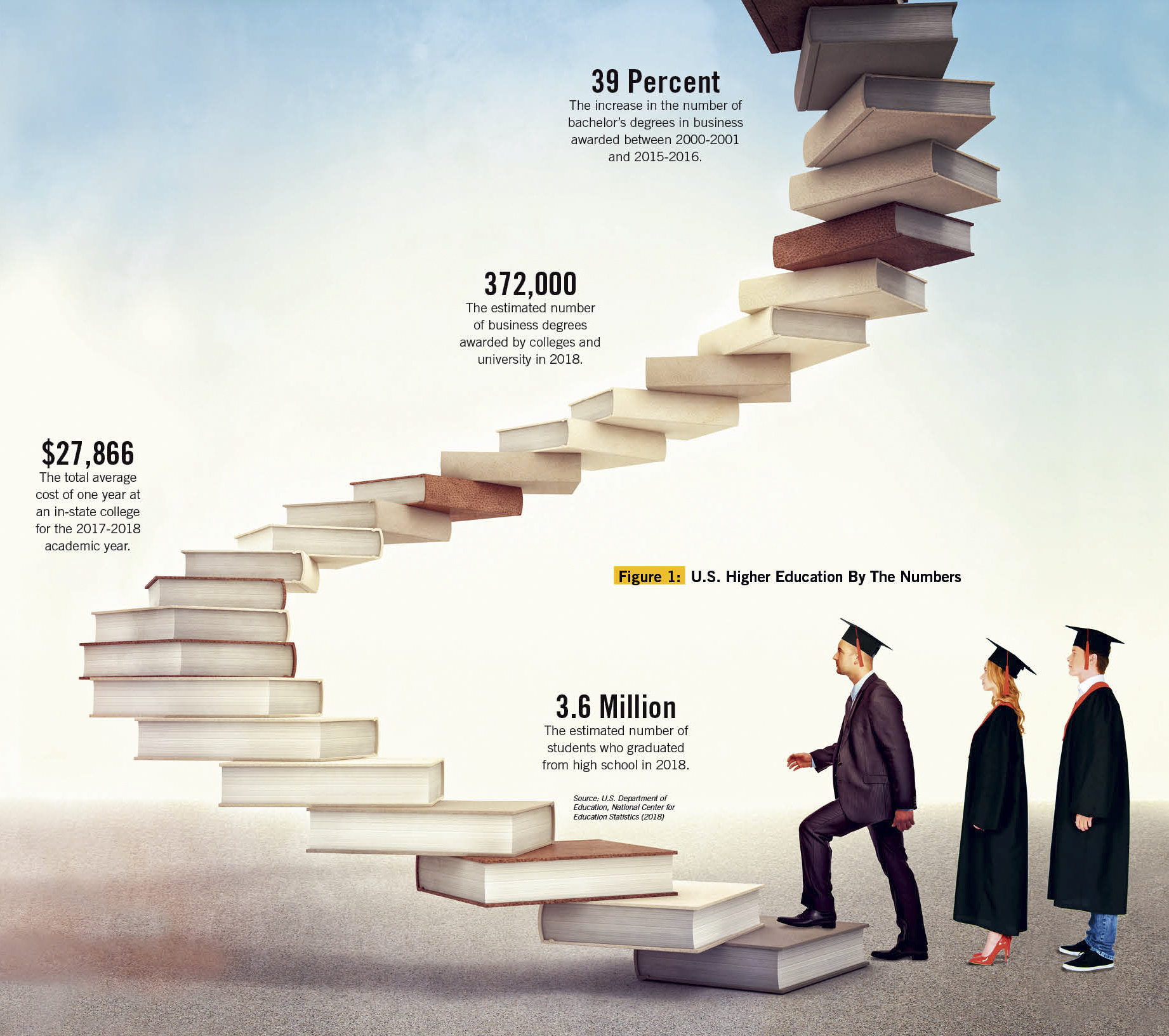
College students today are surrounded by promotional products where they live, work and play. Study results found that 85 percent of AMA student members own university-branded products that were given to them for free, the majority (72 percent) describing these products as “swag.” The term today remains highly controversial within the industry, with some industry professionals embracing the word and others condemning it. While some may associate swag with the acronym “stuff we all get,” the term has a much different connotation for the future generation of marketers.
In its most recent update, The Oxford English Dictionary defines swag as “bold self-assurance in style or manner; an air of great self-confidence or superiority.” The changing contexts of the term are key to understanding how contemporary society views swag’s new value orientation. As consumers first, the student perception of swag portrays their university-branded belongings as part of their persona. Yet, Charity Gibson from supplier company Peerless Umbrella Co. says, “With so many battles to fight, the terminology we use to classify what we do should be the last thing on our minds.”
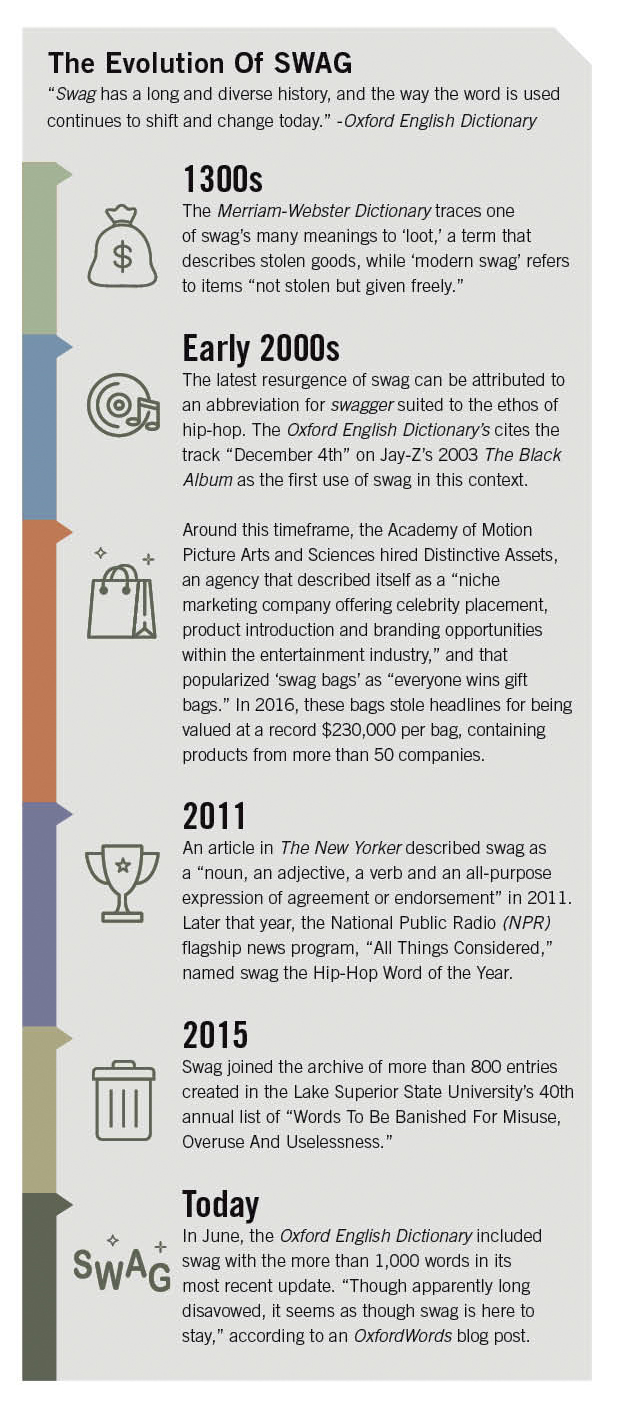
The study found that one ongoing battle for the industry is the misconception of promotional products as “a pretty trivial little piece of marketing,” as one full-time professor put it. Though 90 percent of marketing faculty say they consider promotional products a form of advertising and 79 percent of educators say promotional products are recognized in marketing courses at their institutions, the attention paid to this medium is minimal. One full-time professor said, “As a percentage of a course that deals with introduction to marketing, [promotional products] represent a small percentage of the content, possibly 15 minutes out of a semester-long course.”
Courses most likely to integrate promotional products in their curriculum, although in limited context, are introductory classes, such as Principles of Marketing (58 percent), Advertising and Promotions (58 percent) and Integrated Marketing Communications (52 percent). As an adjunct professor said, “When I taught full-time, promotional materials were discussed in the Principles of Marketing foundational course, as well as in the advertising course. However, promotional products do not expressly fit the definition of advertising.” The majority suggested that course content naturally built promotional products into discussion but used it strictly as an example before moving on to the next topic (Figure 2).

“Promotions are one example of a marketing tactic; thus, they are relatively unimportant to the strategy setting in general,” a full-time professor stated. While the role of promotional products as “instruments for external stakeholders is stressed,” a full-time assistant professor noted, that “the role [of] promotional products in motivating internal audiences, fostering team spirit and boosting organizational pride among employees is rarely addressed.”
A former industry professional and now full-time assistant professor explained, “My sense is that most people think of [promotional products] as a meaningless add-on to marketing or promotional efforts. I think that the industry is not seen as a legitimate or influential form of promotion, and therefore not a viable career path. This could be because many marketing faculty are unaware of the size and scope, as well as the purpose of the industry.” In general, the opportunity for increased visibility seems viable, as a full-time assistant professor noted, “A class for promotional products seems warranted given the industry size and employment.”
Deciding on new or revised educational materials is common among marketing faculty, with 82 percent indicating they have done so within the past two years. Educators are “always looking for information to bring into the classroom,” another full-time associate professor noted.
Changing the required materials for existing courses—either acquired on their own or provided to all students through a materials fee—was most commonly cited (78 percent), followed by substantially modifying a course (73 percent). Though creating a new course was the least common activity, almost one half of faculty (47 percent) had done so over the previous two years.
The study shows a large majority of faculty have some type of role in selecting the educational resources they use in marketing courses (94 percent). Other decision makers may include faculty committees or another faculty member on staff (15 percent), and, in rare cases, individuals from an instructional design group or administration (6 percent).
With the goal of higher education rooted in transitioning consumers into professionals, it is equally important
to effectively communicate to the next generation the ways in which their degrees, interests and talents can lead to successful and fulfilling careers. College grads seeking a career in marketing enter a job market ripe with opportunities. As a senior student pointed out, “There is the research and analytical side, but also the creative and promotional side. Marketing can lead to numerous different professional possibilities down the road.” As the single largest employment category in the nation’s labor force, according to the U.S. Bureau of Labor Statistics, job growth within the field is only expected to accelerate.
When looking for potential jobs, ambitious future marketers want opportunities to gain experience in a favorable work environment (Figure 3). Faculty members understand this, noting, “Students want to learn skills related to interesting, rewarding and profitable career paths. They don’t like the idea of just being a ‘salesperson.’ I’m not aware of theories or concepts that differ for promotional products over other types of products.”

When given the choice between job descriptions, students ranked the promotional products industry as their No. 1 marketing career path (Figure 4). In fact, 81 percent of fourth- and fifth-year students indicated an interest in a potential career as a promotional consultant. But when asked, students say they are drawn to more ‘traditional’ marketing job titles, ranking Promotional Consultant fifth.
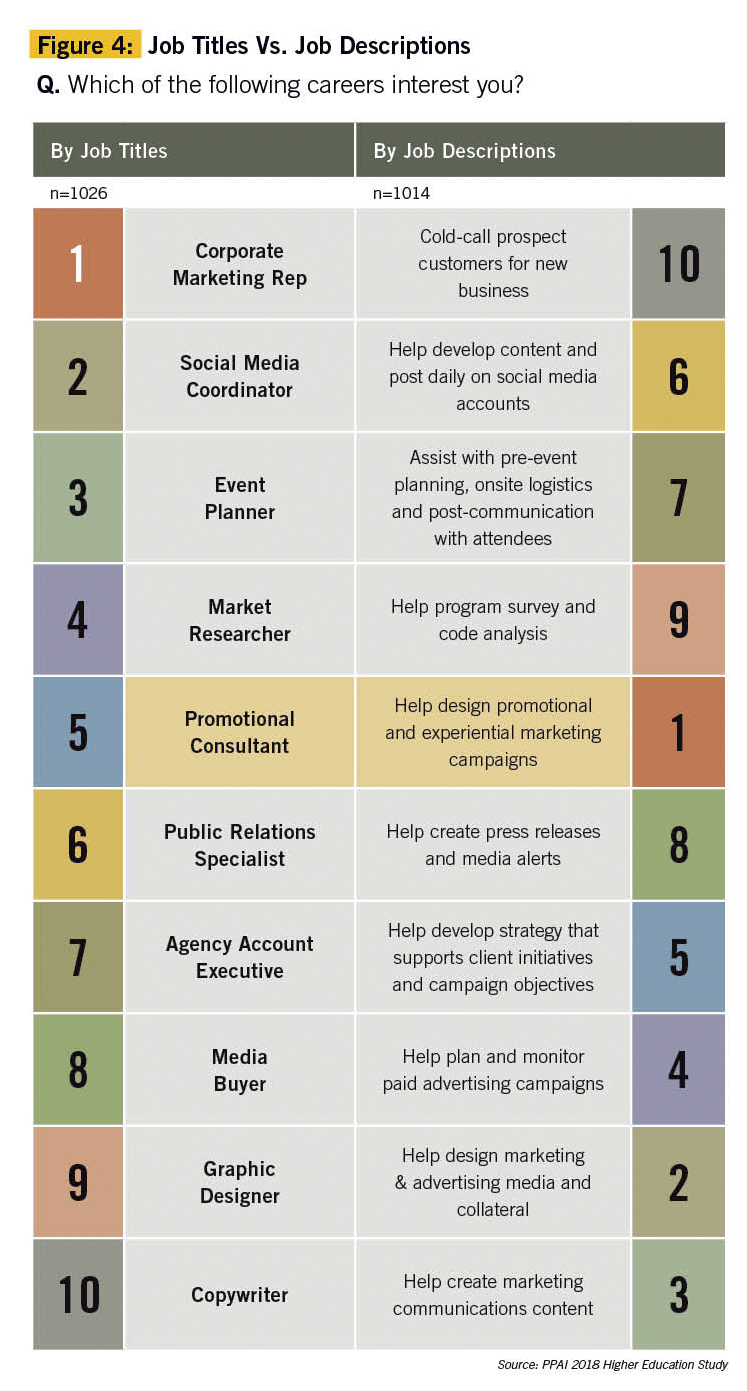
The perception of promotional products in higher education is that “they are everywhere,” one full-time professor explained, “but [they are] not seen as part of a sophisticated and nuanced industry that requires a lot more in-depth thought.” This apparent disconnect illuminates a significant opportunity for the industry “by involving industry partners in teaching,” a full-time lecturer said. “Promotional products can be used as a link” between the institution and the supplier, distributor and business services companies to create forums and educate faculty, future buyers and future peers in the promotional products industry.
To a certain extent, professors are open to this concept by “pointing out to students that they are carrying around insulated coffee cups with the school’s logo on it and making notes using a ballpoint with some company’s promotional message on it,” said a part-time adjunct professor. However, there is a greater need to link these products to the multifaceted $23.3 billion promotional products industry behind them.
Transparency between the classroom and labor markets has become increasingly important because of the growing diversity among undergraduate programs of study, credentials and modes of delivery that are aligned with an increasingly complex set of career pathways. For centuries, experiential learning has proven to effectively bridge the gap between the classroom and the real world, but without awareness of opportunity, perception is stale.
In 1979, authors Wilke English and Dale Lewison stated in a Journal of Marketing Education article that despite the substantial “benefits that accrue to students, professors and the business community,” internships are often overlooked by many industries and thus highly underutilized.
Students who responded to the study, however, placed an emphasis on internships, with 94 percent revealing that the experiences gained are the best preparation for a professional career. Internships were also cited as the top place students expected to learn about the different job opportunities in the marketing field (84 percent).
As a full-time professor reiterated, “The best way to introduce undergraduate students to the career is to have paid summer internships available to them so they can gain firsthand experience.”
Rarely (13 percent) are interns looking for full-time employment in their field. Instead, college students are pursuing internships to develop skills and explore their interests. (Figure 6). Though some may end up becoming the next generation of leaders within the industry, others will go to other careers being better educated to buy promotional products. See sidebar for one former intern’s story.
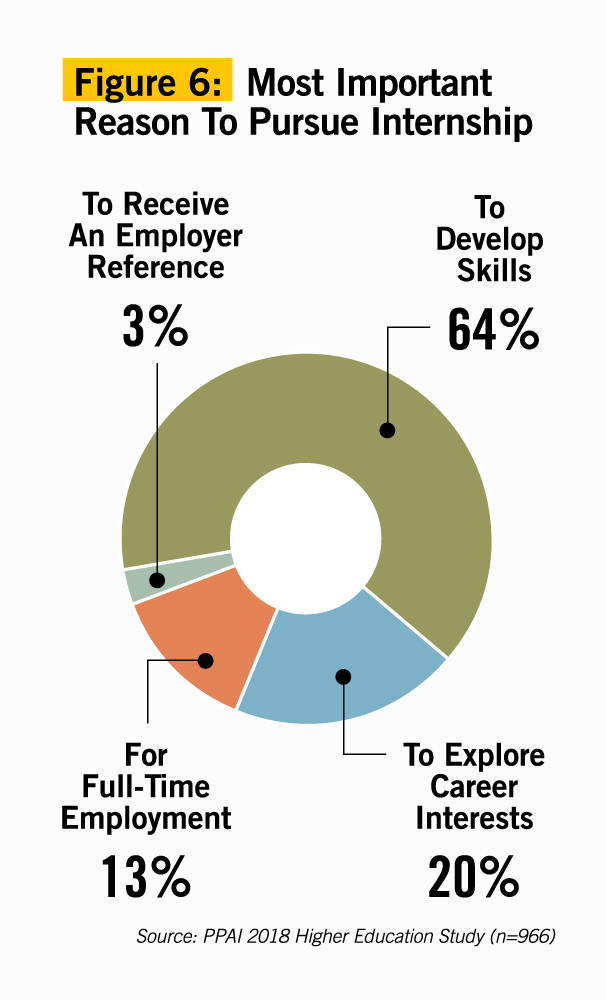
Whereas students are seeking real-world experience, institutions are looking to prepare students with tools to safeguard smooth transitions into the labor market. Despite the profound gains tendered through internship programs, a part-time instructor emphasized “the need for a larger buy-in from the faculty” as well. Faculty are a pivotal resource around which the process and outcomes of higher education revolve.
Though experiential education has been commonplace in standard business-oriented programs, study findings better validate the need for academia and the promotional products industry to work in fluid, collaborative and non-hierarchical models of practice.
The most meaningful and enduring way to defeat the myths and misconceptions of the promotional products industry is for industry companies to create deeper partnerships with the academic community by building dialogue with those who are firmly positioned at the intersection of theory and practice.
While many motivated industry professionals have competing priorities and limited time, schools across the nation have found innovative ways to connect with industry professionals in a manner that balances the experts’ capacity and commitment (Figure 5). These opportunities further leverage a strong partnership to better engage, equip and empower educators to position promotional products as a key component of the mainstream business curriculum.
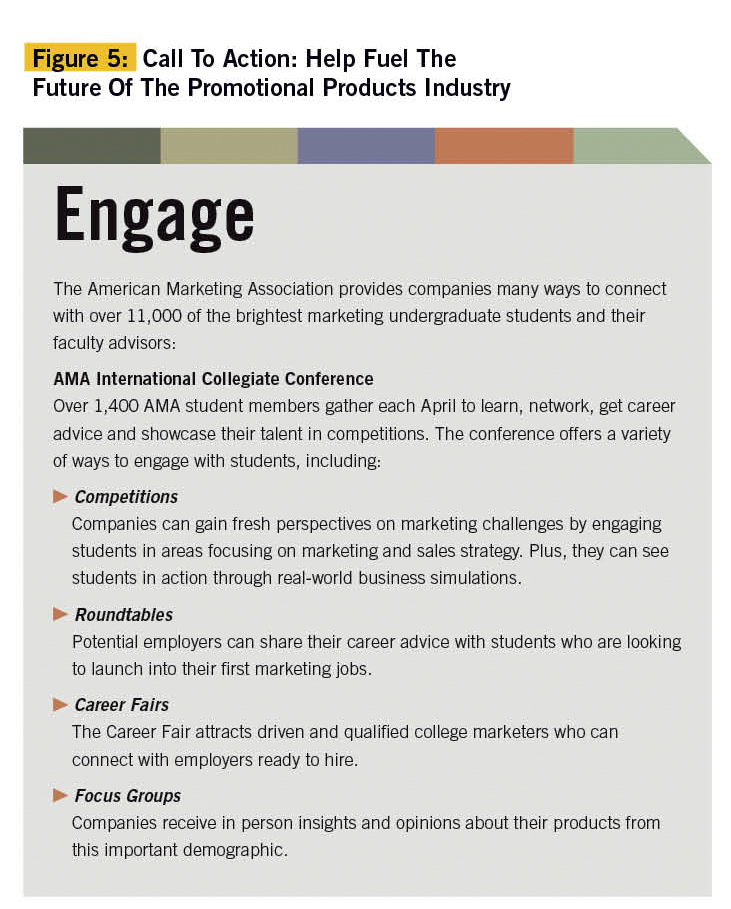
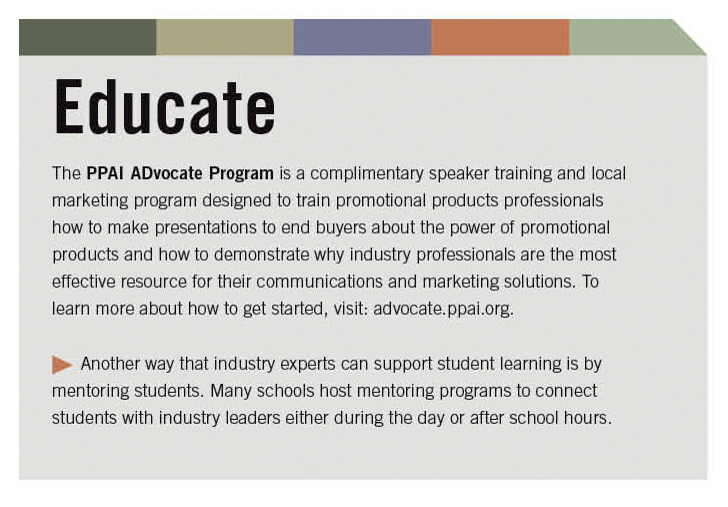
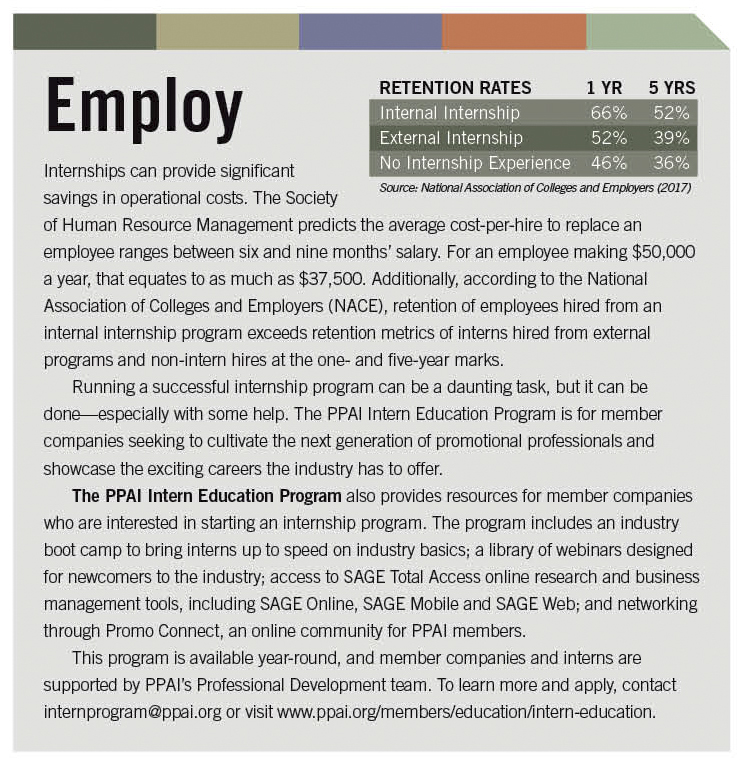
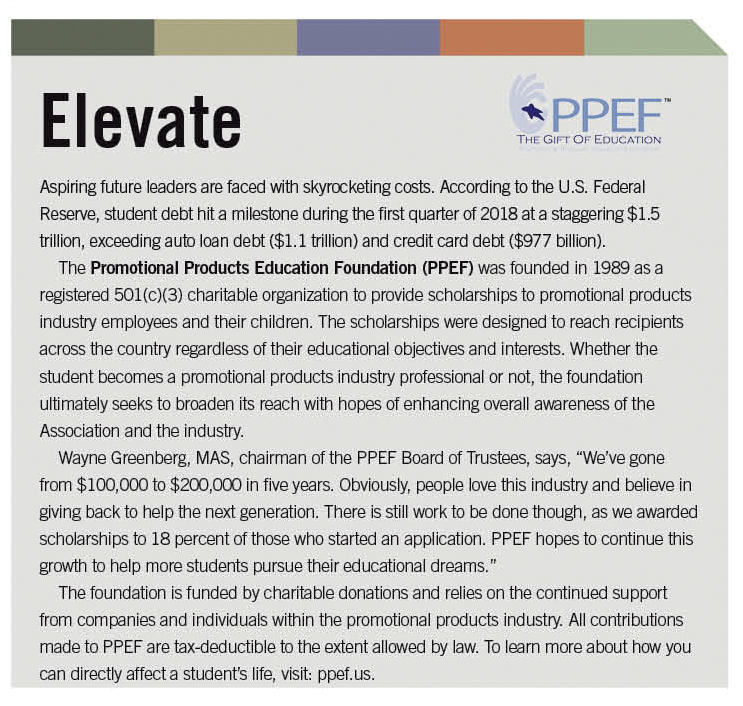
The next generation of talent will be the single most important driver of industry growth. Investing in today’s influencers and tomorrow’s leaders will ensure a bright and prosperous future for the promotional products industry for generations to come. Although bold in undertaking, every conversation, every interaction and every forum will unite to represent a resilient force. “In fact, as a result of taking this survey, I plan to insert this topic into my class this term,” said a part-time adjunct professor. As the great Robert Louis Stevenson once said, “Don’t judge each day by the harvest you reap, but by the seeds that you plant.”
---
Real-World Success Story
How An Internship Opened The Eyes Of A Former AMA Student
As a junior at Quinnipiac University in the fall of 2016, marketing student Matthew Lewis was hoping to find a summer internship much different from his first two experiences at an HR company and hedge fund firm. “I wanted to give myself the opportunity to see how other industries operated,” he said. “I found that by immersing myself for two or three months at different companies, I was able to take enough away from the experience to decide if it was something that I really wanted to do with my life or not.”
After researching a few companies, Lewis lined up three interviews in one day. After the third interview, he accepted an internship with New York City-based Axis Promotions. When asked how he made his decision, he recalled his first impression after reviewing the distributor’s website, describing it as “modern, cool and colorful” and recalled seeing a case study on The Walking Dead, a TV series he enjoyed watching. He was also fond of the big-city location and found the office to be “a laid-back environment.”
Even after three years of marketing and business classes, this AMA member was surprised he had never heard about the promotional products industry. Yet when he embarked on his 10-week internship, “everything changed,” he says. “After completing my internship, I not only found myself familiar with the industry, but I felt a strong sense of comfort in what I was doing as well. There was a mutual feeling of accomplishment. Not only did I feel that I benefited from my experience, but Axis did as well.”
When Lewis returned to college for his senior year, he said he knew he would be back at Axis. “There was a sense of importance at Axis; I was on a team with a common goal where my voice mattered. I had suddenly found myself in a role where my strategy had to be parallel with that of my team.
My decisions affected our clients and they mattered. [The industry] was something that I hadn’t appreciated in school but now could.”
Chasing the positive feelings he found as an intern at Axis led Lewis back to work for the company after graduation. “The internship showed me the importance I could play in the bigger picture of business. By having the opportunity to work with these people beforehand in building confidence and a series of strategies, I knew I was ready for more.”
---
The complete results from the 2018 Higher Education Study will be available as a special report this fall. Access the current collection of PPAI Research by visiting www.ppai.org/research.
Moumita Das is research manager at PPAI.

